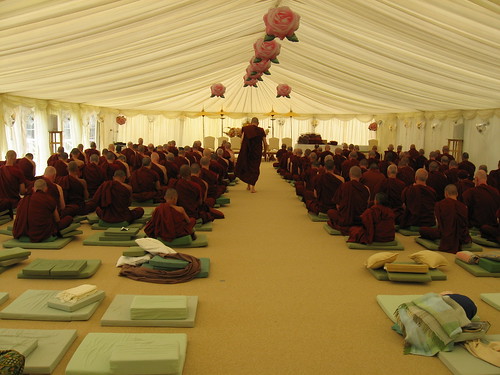Hi,
I've tried searching the forum for the answer to this question, but couldn't find anything. If you know of such a thread, please point me in the direction to it.
People in zen talk about zafu and zabuton all the time, like they are mandatory. Are they? I never use either, mostly I sit directly on the floor, preferably on a mat though. I understand that some people may want to use a zafu for example to get lifted up a bit, so that the knees are touching the ground, and using the zabuton for a softer padding for the knees, but otherwise? Are there any special symbolism in using them? Is it preferred to use them even if one has no need? I mean, how does one instruct newcomers in the matter?
I have been involved with a local sangha a while back, but I never thought about it then. I just used the zafu and zabuton when in the zendo, because they were there, and everybody else used them . Anyway, I have been into zazen for a long while, and I have had my posture checked so that should be OK. I'm also into yoga, so the posture isn't a problem. More interested in the philosophical side, so to speak, or when it started to show up in history, etc.
. Anyway, I have been into zazen for a long while, and I have had my posture checked so that should be OK. I'm also into yoga, so the posture isn't a problem. More interested in the philosophical side, so to speak, or when it started to show up in history, etc.
Maybe not the most important question perhaps, one could do zazen everywhere and anytime, but I'm still curious.
Thanks,
I've tried searching the forum for the answer to this question, but couldn't find anything. If you know of such a thread, please point me in the direction to it.
People in zen talk about zafu and zabuton all the time, like they are mandatory. Are they? I never use either, mostly I sit directly on the floor, preferably on a mat though. I understand that some people may want to use a zafu for example to get lifted up a bit, so that the knees are touching the ground, and using the zabuton for a softer padding for the knees, but otherwise? Are there any special symbolism in using them? Is it preferred to use them even if one has no need? I mean, how does one instruct newcomers in the matter?
I have been involved with a local sangha a while back, but I never thought about it then. I just used the zafu and zabuton when in the zendo, because they were there, and everybody else used them
 . Anyway, I have been into zazen for a long while, and I have had my posture checked so that should be OK. I'm also into yoga, so the posture isn't a problem. More interested in the philosophical side, so to speak, or when it started to show up in history, etc.
. Anyway, I have been into zazen for a long while, and I have had my posture checked so that should be OK. I'm also into yoga, so the posture isn't a problem. More interested in the philosophical side, so to speak, or when it started to show up in history, etc.Maybe not the most important question perhaps, one could do zazen everywhere and anytime, but I'm still curious.

Thanks,








Comment